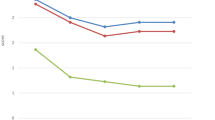Abstract
We observed the promoting effects of the 2940-nm erbium:YAG (Er:YAG) fractional laser in topical drug delivery for psoriasis. A total of five (four males and one female) recalcitrant psoriasis patients were given laser treatment eight times at 1-week intervals with the following parameters: 5–11% spot density and 100-μm energy depth. The psoriatic skin lesions on the left knee and the corresponding lesions at the right ones of each psoriasis patient were randomly divided into two groups: laser + topical drug group (L) and drug alone group (D). The psoriatic lesions in both groups were treated with the same topical treatment (calcipotriol ointment). The corresponding psoriatic lesions in the L group received extra 2940-nm Er:YAG laser irradiation before topical treatment. The photos of psoriatic lesions were taken before each treatment. The final photos were obtained from the patients at the seventh day after the final treatment. Drug alone or in combination with laser Er:YAG both reduced psoriatic lesions. However, with the increase in the number of treatments, increasing differences were observed between the treatment and the control sides. The therapeutic outcomes in the L groups were better than those in the D groups. Psoriasis area and severity index (PASI) scores for five cases of both groups were decreased. However, the scores in the L groups were lower than those in the D groups. The use of 2940 nm Er:YAG promoted the absorption of topical drugs for psoriasis, improving the therapeutic effect.

Similar content being viewed by others
References
Stern RS, Nijsten T, Feldman SR et al (2004) Psoriasis is common, carries a substantial burden even when not extensive, and is associated with widespread treatment dissatisfaction[J]. J Investig Dermatol Symp Proc 9(2):136–139
Nograles KE, Davidovici B, Krueger JG (2010) New insights in the immunologic basis of psoriasis[J]. Semin Cutan Med Surg 29(1):3–9
Cevc G (1997) Drug delivery across the skin[J]. Expert Opin Investig Drugs 6(12):1887–1937
Ongpipattanakul B, Burnette RR, Potts RO et al (1991) Evidence that oleic acid exists in a separate phase within stratum corneum lipids[J]. Pharm Res 8(3):350–354
Lee WR, Shen SC, Wang KH et al (2002) The effect of laser treatment on skin to enhance and control transdermal delivery of 5-fluorouracil[J]. J Pharm Sci 91(7):1613–1626
Fang JY, Hwang TL, Huang YB et al (2002) Transdermal iontophoresis of sodium nonivamide acetate. V. Combined effect of physical enhancement methods[J]. Int J Pharm 235(1–2):95–105
Lee WR, Shen SC, Lai HH et al (2001) Transdermal drug delivery enhanced and controlled by erbium:YAG laser: a comparative study of lipophilic and hydrophilic drugs[J]. J Control Release 75(1–2):155–166
Jiang H, Zhang X, Wang J et al (2015) Er:YAG fractional laser as a percutaneous absorption promoter for controlled delivery of antibody in vitro[J]. J Control Release 213:e56
Fredriksson T, Pettersson U (1978) Severe psoriasis—oral therapy with a new retinoid[J]. Dermatologica 157(4):238–244
Desmet E, Bracke S, Forier K et al (2016) An elastic liposomal formulation for RNAi-based topical treatment of skin disorders: proof-of-concept in the treatment of psoriasis[J]. Int J Pharm 500(1–2):268–274
Peppin JF, Pappagallo M (2014) Capsaicinoids in the treatment of neuropathic pain: a review[J]. Ther Adv Neurol Disord 7(1):22–32
Jepps OG, Dancik Y, Anissimov YG et al (2013) Modeling the human skin barrier—towards a better understanding of dermal absorption[J]. Adv Drug Deliv Rev 65(2):152–168
Schoellhammer CM, Blankschtein D, Langer R (2014) Skin permeabilization for transdermal drug delivery: recent advances and future prospects[J]. Expert Opin Drug Deliv 11(3):393–407
Finnin BC, Morgan TM (1999) Transdermal penetration enhancers: applications, limitations, and potential[J]. J Pharm Sci 88(10):955–958
Drnovsek-Olup B, Beltram M, Pizem J (2004) Repetitive Er:YAG laser irradiation of human skin: a histological evaluation[J]. Lasers Surg Med 35(2):146–151
Manaloto RM, Alster T (1999) Erbium:YAG laser resurfacing for refractory melasma[J]. Dermatol Surg 25(2):121–123
Fang JY, Lee WR, Shen SC et al (2004) Transdermal delivery of macromolecules by erbium:YAG laser[J]. J Control Release 100(1):75–85
Trelles MA, Allones I, Luna R (2002) One-pass resurfacing with a combined-mode erbium: YAG/CO2 laser system: a study in 102 patients[J]. Br J Dermatol 146(3):473–480
Tanzi EL, Alster TS (2003) Single-pass carbon dioxide versus multiple-pass Er:YAG laser skin resurfacing: a comparison of postoperative wound healing and side-effect rates[J]. Dermatol Surg 29(1):80–84
Kirby JD, Munro DD (1976) Steroid-induced atrophy in an animal and human model. Br J Dermatol. 94(Suppl 12):111–119
Guin JD (1984) Contact sensitivity to topical corticosteroids. J Am Acad Dermatol 10:773–782
Acknowledgments
The authors are grateful to Mr. Shaoli Cheng (Medicine School of Xi’an Jiaotong University, China) in critically revising the manuscript. This study was supported by a grant of Project of Natural Science Foundation Research Project of Shaanxi Province (2016JM8124)
Author information
Authors and Affiliations
Contributions
All authors were involved in drafting the article or revising it critically, and all authors approved the final version to be published.
Study conception and design: Ruilian Li, Shengxiang Xiao, and Huiqun Ma
Acquisition of data: Ruilian Li, Jun Zhou, Hui Su, Mei Wang, and Yongxian Wang
Analysis and interpretation of data: Jun Zhou, Hui Su, Mei Wang, and Yongxian Wang
Corresponding authors
Ethics declarations
This study was approved by the medical ethics committee of the Second Affiliated Hospital of Xi’an Jiaotong University, China. Informed consent was obtained from all participants prior to the study.
Conflict of interest
The authors declare that they have no competing interests.
Rights and permissions
About this article
Cite this article
Li, R., Zhou, J., Su, H. et al. 2940-nm Er:YAG fractional laser enhanced the effect of topical drug for psoriasis. Lasers Med Sci 32, 1393–1397 (2017). https://doi.org/10.1007/s10103-017-2259-x
Received:
Accepted:
Published:
Issue Date:
DOI: https://doi.org/10.1007/s10103-017-2259-x




